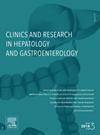The impact of incidental hepatocellular carcinoma in liver transplantation: A growing concern
IF 2.6
4区 医学
Q2 GASTROENTEROLOGY & HEPATOLOGY
Clinics and research in hepatology and gastroenterology
Pub Date : 2025-02-06
DOI:10.1016/j.clinre.2025.102550
引用次数: 0
Abstract
Incidental hepatocellular carcinoma (iHCC) is a growing concern in liver transplantation, where tumors are unexpectedly discovered during histopathological examination of explanted livers. The prevalence of iHCC varies widely, with reported rates between 1.6 % and 40 %, influenced by differences in diagnostic practices and patient populations. Recent studies, including that by Kerstens et al., highlight the clinical significance of iHCC, revealing its association with alcohol-related liver disease and the limitations of current surveillance strategies. Conventional imaging techniques, such as ultrasound, often fail to detect small tumors, leading to delayed diagnosis. Advanced imaging modalities, including MRI, and emerging biomarkers, such as des-γ-carboxy prothrombin (DCP), are improving detection, but further research is needed to refine diagnostic protocols. The growing recognition of Metabolic Dysfunction-Associated Steatotic Liver Disease (MASLD) complicates the surveillance of iHCC, particularly as patients with MASLD often present with subtle or atypical clinical profiles. Personalized surveillance, incorporating advanced technologies like liquid biopsy and artificial intelligence, holds promise for improving early detection. Additionally, individualized post-transplant management strategies are crucial, given the lower survival rates observed in iHCC patients. As our understanding of iHCC evolves, a shift toward more tailored approaches in diagnosis, surveillance, and treatment is essential to improve outcomes and reduce the burden of incidental HCC in liver transplantation.
肝移植中偶发肝细胞癌的影响:日益受到关注
偶发性肝细胞癌(iHCC)在肝移植中越来越受到关注,在移植肝脏的组织病理学检查中意外发现肿瘤。受诊断方法和患者群体差异的影响,iHCC的患病率差异很大,报道的发病率在1.6%至40%之间。最近的研究,包括Kerstens等人的研究,强调了iHCC的临床意义,揭示了其与酒精相关肝病的关联以及当前监测策略的局限性。传统的成像技术,如超声,往往不能检测到小肿瘤,导致延迟诊断。先进的成像方式,包括MRI和新兴的生物标志物,如des-γ-羧基凝血酶原(DCP),正在改善检测,但需要进一步的研究来完善诊断方案。越来越多的人认识到代谢功能障碍相关脂肪变性肝病(MASLD)使iHCC的监测复杂化,特别是MASLD患者通常表现出微妙或不典型的临床特征。结合液体活检和人工智能等先进技术的个性化监测有望改善早期检测。此外,鉴于iHCC患者的生存率较低,个性化的移植后管理策略至关重要。随着我们对iHCC认识的发展,在诊断、监测和治疗方面向更有针对性的方法转变对于改善肝移植中偶发HCC的预后和减轻负担至关重要。
本文章由计算机程序翻译,如有差异,请以英文原文为准。
求助全文
约1分钟内获得全文
求助全文
来源期刊

Clinics and research in hepatology and gastroenterology
GASTROENTEROLOGY & HEPATOLOGY-
CiteScore
4.30
自引率
3.70%
发文量
198
审稿时长
42 days
期刊介绍:
Clinics and Research in Hepatology and Gastroenterology publishes high-quality original research papers in the field of hepatology and gastroenterology. The editors put the accent on rapid communication of new research and clinical developments and so called "hot topic" issues. Following a clear Editorial line, besides original articles and case reports, each issue features editorials, commentaries and reviews. The journal encourages research and discussion between all those involved in the specialty on an international level. All articles are peer reviewed by international experts, the articles in press are online and indexed in the international databases (Current Contents, Pubmed, Scopus, Science Direct).
Clinics and Research in Hepatology and Gastroenterology is a subscription journal (with optional open access), which allows you to publish your research without any cost to you (unless you proactively chose the open access option). Your article will be available to all researchers around the globe whose institution has a subscription to the journal.
 求助内容:
求助内容: 应助结果提醒方式:
应助结果提醒方式:


